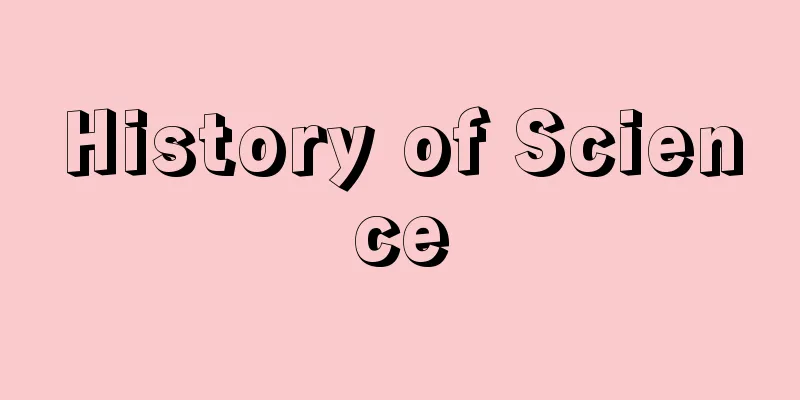History of Science

|
Science is divided into natural science and social science. In a broad sense, the history of science covers the history of both academic disciplines, but it generally focuses on the history of natural science. Natural science is an intellectual activity conducted under the intertwining of various social conditions, including politics, economics, and culture, and these conditions have a great influence on the development of science. Science also influences politics, economics, and culture, and is involved in the formation of thought, influencing ideology. The study of the history of science, which focuses on natural science, is not merely the "history of science," that is, the enumeration and mention of past scientific achievements. By examining the development of the methods and systems of natural science as a logical process and by examining natural science and the social relationships in which it is situated, the study of the history of science as an independent historical science can be established. Below, I would like to consider the development of the history of science and clarify the current issues that the history of science faces. [Susumu Takayama] The origins of scienceThe history of alchemy appears in the texts written by medieval alchemists. Stating how alchemy had continued unbroken since ancient times was one way of establishing its authority. Modern science has made extensive use of observational results and theories from ancient Greece and earlier times, and has created new systematizations, but no comprehensive history of science has been written. Nevertheless, in astronomy, observational data from the Babylonian and Greek eras was used until the time of Copernicus in the 16th century, and modern mechanics is based on the theories of Euclid and Archimedes, impressing upon people the inheritance and historicity of knowledge. In the 17th century, shortly after the Royal Society of England was founded, Thomas Sprat (1635-1713) was commissioned to compile the History of the Royal Society (1667). The work provided historical justification for the importance of experimental science, which was the society's purpose. [Susumu Takayama] Individual and Integrated History of ScienceFrom the end of the 18th century to the 19th century, attempts began to appear to describe individual fields of science along their historical development. One style was to combine the history and current state of individual sciences, as Priestley did in his history of electricity and optics, and Thomas Thomson (1773-1852) did in his history of chemistry. The other group were collected works that were compiled as histories of individual sciences, such as Jean Sylvain Bailly's (1736-1793) Ancient Astronomy (1775) and Modern Astronomy (1778-1782), Jean-Baptiste Joseph Delambre's (1749-1822) History of Ancient Astronomy (1817), Jean Étienne Montucla's (1725-1799) History of Mathematics (1758), Johann Carl Fischer's (1760/1761-1833) History of Physics (1801-1808), and Johann Friedrich Gmelin's (1748-1804) History of Chemistry (1797-1799). As the theoretical systems of individual sciences were established and textbooks began to be compiled around these systems, some textbooks contained almost no historical descriptions, and a wide variety of methods for systematically describing the natural sciences coexisted. The 19th century saw the production of many works on the history of individual sciences, including The History of Physical Astronomy (1852) by the British Robert Grant (1814-1892), The Origin and Development of Organic Chemistry (1879) by Schallenberg, A History of Astronomy in the Nineteenth Century (1885) by Agnes M. Clarke (1842-1907), A History of Ether and Electricity (1910) by Edmund T. Whittaker (1873-1956), The History of Chemistry (1843-1847) by the German Kopp, History of Mineralogy (1864) by Franz von Kobell (1803-1882), and History of Zoology (1872) by Julius Victor Carus (1823-1903). It was Comte, who established the philosophy of positivism, and William Whewell (1794-1866), an advocate of the hypothetical-deductive method, who proposed a "general history of science" that goes beyond the framework of the history of individual sciences and summarizes the history of all natural sciences through a certain philosophical perspective. Comte positioned the history of science in his "Lectures on Positive Philosophy" (1830-1842), while Whewell wrote "The History of Inductive Sciences" (1837). Comte's friend Pierre Laffitte (1823-1903) became a professor of "General History of Science" at the University of Paris in 1892, while Mach, who was in the lineage of positivism, became a professor of "Philosophy, especially the history and theory of inductive science" at the University of Vienna in 1895. Mach based the ideas of positivism and energetics by critically reconstructing the history of individual sciences, such as the history of mechanics and the history of thermodynamics. It can be said that it was around this time that the history of science began to be recognized as an academic discipline. George AL Sarton (1884-1956), who contributed to establishing the history of science as a specialized field, was an ideological positivist. His bibliographical work, An Introduction to the History of Science (1927-1947, translated into Japanese as The History of Science in Ancient and Medieval Times), covered the period from ancient times to the 14th century, and was comprehensive in its scope, not limited to individual histories, and not limited to Europe. He also founded the history of science journal Isis (1913), and organized the first international conference on the history of science (1929), working to establish and popularize the history of science. [Susumu Takayama] The beginning of the history of science in generalB. Hessen (1893-1936), who participated in the Second International Congress of the History of Science from the Soviet Union in 1931, attracted attention with his report on the "social and economic foundations of Newton's Principia" based on the "materialist interpretation of history" proposed by Marx. Hesse sought the causes of the work of Newton and other scientists in the formative period of modern science in society. In other words, in an era when feudalism collapsed and merchant capitalism emerged, transportation, mining, and the military industry flourished, and the technical challenges that arose from these industries prompted natural scientists to tackle problems in mechanics, and he argued that Newton's completion of mechanics was based on the accumulation of these efforts. He also stated that the image of God that Newton used to summarize his system of mechanics was deeply permeated, which reflected the worldview of the emerging bourgeoisie at the time. Hesse's paper had a great impact on young historians of science in Europe and the United States. Bernal, James Gerald Crowther (1899-1983), Needham, and R. K. Merton studied the social relations of science from various aspects. Bernal, in The Social Function of Science (1929), discussed science as a broad social phenomenon. Crowther, in The Social Relations of Science (1941), proved the relationship by writing a general history of science. Needham began his research on the history of science in China by asking the question, "Why did modern science develop only in Europe and not in Chinese civilization?" and sought the reason in the difference in social structure between Europe and China. Merton, in Science, Technology, and Society in Seventeenth-Century England (1938), documented Hesse's argument and established the proposition that economic and technological demands gave direction to scientific research in seventeenth-century England. Merton's second thesis was that Puritanical ethics were an important factor in the development of science in 17th-century England. As mentioned above, it was not until the 1930s that it became clear that the history of science could be discussed not only within the intellectual and spiritual framework, but also in relation to the various factors that general history deals with. If we distinguish the history of science that is positioned in general history from the history of individual sciences and the history of comprehensive science as the general history of science, then the 1930s could be said to be the era when the possibility of the general history of science was opened up. At the beginning of The Social Function of Science, Bernal writes, "As long as the results of science appeared as a pure benefit, at least to the middle and higher classes, the social function of science was obvious and did not require any consideration. However, today, when science has come to play both a constructive and a destructive role, and its very right to exist is being denied, its social function must be considered." Bernal's motivation was to reexamine the social value of science in a broader sense, in the midst of a series of incidents in which science was financially and ideologically oppressed in connection with social events such as the economic depression and the emergence of fascism. [Susumu Takayama] Establishment of an internal history of scienceIn 1939, Koyré published Studies on Galileo. Using a vast amount of primary sources, he proved that it was none other than the ancient intellectual tradition that influenced Galileo's formation of mechanics, and stated that "the mechanisms of classical natural science are not the ideas of craftsmen or engineers, but are the very negation of them," directly rejecting the view of the "external history of science" pioneered by Hesse, Bernal, Needham, and others. As evidence, he emphasized that Galileo did not rely on experience or experiments, but instead assumed ideal states such as perfect spheres and smooth planes that do not exist in reality, and inferred through thought experiments and mathematics. Koyré cited the ancient Greeks Archimedes and Plato as pioneers of this method, and declared Galileo to be a Platonist. In From a Closed World to an Infinite Universe (1957), he also characterized the transformation of the view of nature on which modern mechanics was based as "the dismantling of the cosmos (the hierarchically ordered universe) and the geometrization of space." These works marked the starting point of the trend toward the "internal history of science," and their basic stance was expressed by Alfred Rupert Hall's (1920-2009) words, "intellectual change must find its explanation in the history of the intellect." After the Second World War, in 1949, historian Butterfield published The Birth of Modern Science, an attempt to place science within general history while following the position of "internal scientific history." In this work, he argued that the development of individual sciences in 17th century Europe was brought about by scientists reexamining nature "with new thinking hats on," and described this as a "scientific revolution," giving this revolution a high reputation in human history and calling it "the true father of the modern world and modern spirit." Butterfield's argument that the "scientific revolution" was a creative product of Europe and provides a more important period in modern times than the Renaissance or the Reformation is known as the "scientific revolution theory." The "internal history of science" established by Koyré and Butterfield, or the history depicted through the interrelationship between thought and science, coincided with the period when the history of science was being established as a specialized field, and many excellent works were produced. Representative researchers include Marshall Clagett (1916-2005), I. Bernard Cohen (1914-2003), Charles Coulston Gillispie (1918-2015), Kuhn, and Hall. In the 1950s and 1960s, the "internal history of science" dominated the study of the history of science, but Hall, as mentioned above, argued that the "external history of science" says very little about science itself, and that it is inappropriate to say that natural science is "causally determined" by economic and social conditions, and therefore argued for the superiority of the internal history of science. The background to his argument is the same "scientific revolution theory" view of history as Butterfield. In other words, his position was that because science has such a deep meaning that it transcends other social factors, an independent history of science should be written, and he assumed a different social position for science than did Bernal. [Susumu Takayama] Recent FeaturesAs mentioned above, the way the history of science is perceived has changed over time. To summarize, the shape of the history of science has been determined largely by two factors: (1) changes in the image of science in society, or changes in the historians of science's own perceptions of science and society, and (2) the establishment of methods for the history of science to be viable as a specialized study. Since the 1970s, the study of science history has been producing various research results, focusing on the relationship between the institutions (schools, universities, academies, academic societies, research institutes, etc.) created by scientists and scientific research. Considering this change, which can be said to be the revival of the "external history of science," in light of the above two points, (1) from the late 1960s to the 1970s, pollution and environmental problems came to the fore, and the strong science and technology policies consistently promoted by the state after the war, which led to the military-centered policy, and the Vietnam War and nuclear weapons becoming social issues, science could no longer be thought of as a purely intellectual activity separated from society. (2) The sociology of science founded by Merton gradually produced results, and in the 1970s, results began to be published one after another. In addition, Kuhn and others enthusiastically argued that the "internal history of science" and the "external history of science" could not be discussed in isolation from each other, but should be integrated. Kuhn maintained the position that a shift in scientific theory is ultimately mediated by a group of scientists. A group of scientists works under a certain paradigm, but it is ultimately a different paradigm and a different group of scientists that overcomes the paradigm crisis. In this way, Kuhn opened the way to discuss the relationship between scientific knowledge and a group of scientists, and advocated the fusion of the "internal" approach and the "external" approach. Thus, in the 1970s, the issue of the relationship between science and the society of scientists, i.e., the science system, began to attract attention, and the subject of research has gradually shifted from the 17th century modern science to the history of science in the 19th and 20th centuries. In recent years, research on the history of physics in the 19th century has been accumulating results, focusing on academic fields that are unified by common research methods (such as the Laplace method, the Fourier method, and the energy physics method), and dealing with the relationship between the content of physics and its institutional characteristics. In addition, there has been an increase in research on the situation in which science approached technology and was incorporated into the industrial world from the 19th to 20th centuries, focusing on the process by which certain academic fields became independent and institutionalized, and dealing with both so-called "internal" and "external" factors. [Susumu Takayama] The state and challenges of scientific historyWhat is needed today is a history of science that places science in relation to society, traces its development, answers the various problems of modern science, and predicts the ideal relationship between science and society in the future, and the question of how to achieve this is being asked. Even if we are talking about an "external history of science," it would be insufficient to stop at the study of the relationship between science, the scientific system, and the scientific community. Only by drawing a history of science that is clearly positioned in general history and society can we present a view of science that can answer modern problems. Let us take the formation of modern science as an example. As Koyle and others have made clear, the mechanistic view of nature, which is the philosophy of modern science, is a view of nature that is compatible with the new theories of the universe, mechanics, and matter at the time, and is a view of nature that was prompted by such changes in science. However, it is insufficient to dismiss this view of nature and the transformation of natural science as a sudden event or a revival of ancient thought without questioning the historical and social causes of this view of nature and the transformation of natural science. The mechanistic view of nature was established as a position that rejected various views of nature, such as scholastic teleology, the explanation of nature by mystical hidden powers (occult powers), or the acceptance of religious revelation and miracles. It was one aspect of the values that people chose in Europe during the structural transformations of the Renaissance and the Reformation from the Middle Ages to the modern era, and especially in the 17th century, when religious wars, plagues, and harvest failures occurred one after another and people faced serious social, economic, and cultural crises. Modern science was formed under such circumstances, as the activities of newly emerging merchants and craftsmen overlapped with the process in which technology, which was despised in medieval society, became the subject of academic study. Hesse and Needham questioned the relationship between science and society in this broad sense, and there is still much to learn from them. In his essay "The Social and Economic Foundations of Newton's Principia," Hesse examines the historical necessity of the succession of scientific knowledge and its social basis, such as the relationship between the activities of commercial capitalism in the 16th and 17th centuries and the formation of technology and mechanics in the manufacturing era, or the relationship between industrial capitalism, the emergence of the steam engine, and the awareness of energy. Such a comprehensive theme cannot be dealt with within the framework of Kuhn's discussion of a paradigm shift arbitrarily chosen by a group of scientists. For example, when questioning the necessity of the drastic shift from classical physics to modern physics in the 20th century and its social basis, it is necessary to construct an argument that includes economic factors such as the improvement of electrical technology and related experimental techniques since the second half of the 19th century, and the investment of capital in science and technology by industry and the state under monopoly capitalism. Needham also inherited the spirit of Hesse while addressing the history of science in China. He asks the question of why modern science developed only in Europe, and also asks the question, "Why was Chinese civilization far superior to Western civilization in applying knowledge of nature to the real needs of human beings from the 1st century BC to the 15th century AD?" and attempts to clarify the historical issue by considering the significance of the unique Chinese bureaucracy that had developed since ancient times, the enthusiastic support of the state for science, and the status of scholars in society. There is much to be learned from Needham's position, which regards the unique scientific traditions of non-European cultural spheres as a whole in themselves, questions their characteristics, discusses their development, and then compares them with Europe. Needham stated as early as the mid-1960s, "I am convinced that in this time of crisis in Europe, interest in the relationship between science and society will be greatly revived." Today, when science and technology have become so large that they can determine the fate of humanity, a history of science that can give science its correct social position is needed. [Susumu Takayama] "The History of Science, Volumes 1 and 2, by S. Mason, translated by Yajima Yuri (1955, 1956, Iwanami Shoten) " ▽ "Science in History, Volumes 4, by J.D. Bernal, translated by Chinme Yasuo (1967, Misuzu Shobo)" ▽ "The Science of Science: Society in the Age of Science and Technology, edited by M. Goldsmith and A. Mackay, translated by Korenaga Sumihiro (1969, Hosei University Press)" ▽ "Science and Civilization in China, Volumes 11, by J. Needham, supervised by Higashihata Seiichi and Yabuuchi Kiyoshi (1980-1983, Shisosha)" ▽ "The Death of Nature: Scientific Revolution and Women and Ecology, by Carolyn Merchant, translated by Dan Marina et al. (1985, Kousakusha)" ▽ "What is Technology? From the Perspective of Science and Humanity, by Murakami Yoichiro (1986, NHK Publishing Association)" ▽ Ito Shuntaro and Murakami Yoichiro (eds.), Lecture Series on the History of Science, 4 volumes (1989, 1990, Baifukan) ▽ Murakami Yoichiro, Science in Civilization (1994, Seidosha) ▽ Onuma Masanori, Thinking about Human History 12: Technology and Labor (1995, Iwanami Shoten) ▽ Steven Shapin, What Was the Scientific Revolution? - An Attempt at a New View of History, translated by Kawada Masaru (1998, Hakusuisha) ▽ Nakayama Shigeru and Yoshioka Hitoshi (eds.), The Present History of the Scientific Revolution - For a Sustainable Future for Japan (2002, Gakuyo Shobo) ▽ Thomas Kuhn, Essential Tensions in the Scientific Revolution, translated by Abiko Seiya and Sano Masahiro, new edition (2018, Misuzu Shobo) ▽ H. Butterfield, The Birth of Modern Science, translated by Watanabe Masao (Kodansha Academic Library) ▽ "The Historical Structure of Scientific Revolutions" by Chikara Sasaki, Vol. 1 and 2 (Kodansha Academic Library) [Reference item] |Source: Shogakukan Encyclopedia Nipponica About Encyclopedia Nipponica Information | Legend |
|
科学には、自然科学と社会科学がある。科学史は広義には両者をあわせた学問の歴史をその対象とするが、一般には自然科学の歴史を対象とする。 自然科学は、政治、経済、文化などの社会的諸条件が絡み合った状況の下で営まれる知的活動であるから、それらの諸条件は科学の発展に大きく影響を及ぼす。また科学が政治、経済、文化に影響を与え、思想形成にかかわってイデオロギーに影響を与える。そうした自然科学を対象とする科学史という学問は、単なる「科学の歴史」、つまり過去の科学的業績の列挙や言及だけにとどまるものではない。自然科学の方法と体系の発展を論理的過程として考察し、自然科学とそれが位置する社会的諸関係を考究することによって、独立した歴史科学としての科学史研究が成立すると考えられる。以下、科学史の発展過程を考察し、科学史のもつ今日的課題などを明らかにしたい。 [髙山 進] 科学史のおこり中世の錬金術師の書いたテキストには錬金術の歴史が登場する。錬金術がいかに古代から連綿と続いてきたかを述べることが一つの権威づけの手段となった。近代科学は古代ギリシアやそれ以前の観測結果や理論を大いに利用し、新しい体系化を行ったが、まとまった科学史が記述されることはなかった。それでも天文学では、バビロニアやギリシアの時代の観測データが16世紀のコペルニクスのころまで利用されたし、近代の力学はユークリッドやアルキメデスの理論に依拠しており、知識の継承性、歴史性を人々に印象づけた。 17世紀、イギリスのロイヤル・ソサイエティーが創立された直後にスプラットThomas Sprat(1635―1713)が依頼されてまとめた『王立協会史』(1667)は、協会としての目的である実験科学の重要性を人々に訴えるために歴史的根拠づけを行ったものである。 [髙山 進] 個別科学史と総合科学史18世紀末から19世紀にかけて、科学の個別諸分野を歴史的展開過程に沿って記述する試みが現れ始めた。一つは個別科学の歴史と現状の両者を融合させて記述するスタイルで、プリーストリーが電気学史と光学史で行い、トムソンThomas Thomson(1773―1852)が化学史で行った。もう一つは個別科学史としてまとまった著作で、ベイリーJean Sylvain Bailly(1736―1793)の『古代天文学』(1775)と『近代天文学』(1778~1782)、ドランブルJean-Baptiste Joseph Delambre(1749―1822)の『古代天文学史』(1817)、モンテュクラJean Étienne Montucla(1725―1799)の『数学史』(1758)、フィッシャーJohann Carl Fischer(1760/1761―1833)による『物理学史』(1801~1808)、グメーリンJohann Friedrich Gmelin(1748―1804)の『化学史』(1797~1799)などがまとめられた。個別科学の理論体系が確立し、それらの体系を中心に教科書が編まれるようになると、教科書のなかにほとんど歴史的記述が位置づけられないものもあり、自然科学の体系的な叙述の方法にさまざまな種類のものが並存した。 19世紀には個別科学史の業績が数多く生み出された。イギリスのグラントRobert Grant(1814―1892)の『物理的天文学の歴史』(1852)、ショルレンマーの『有機化学の起源と発展』(1879)、クラークAgnes M. Clarke(1842―1907)の『19世紀天文学史』(1885)、ホイッタカーEdmund T. Whittaker(1873―1956)の『エーテルと電気の歴史』(1910)、ドイツのコップの『化学の歴史』(1843~1847)、コベルFranz von Kobell(1803―1882)の『鉱物学史』(1864)、カルスJulius Victor Carus(1823―1903)の『動物学史』(1872)などがあげられる。 個別科学史の枠を超え、自然科学全体の歴史をある一定の哲学的見解によってまとめあげる「総合科学史」を提起したのは、実証主義哲学を確立したコントと、仮説演繹(えんえき)法の提唱者であったヒューウェルWilliam Whewell(1794―1866)であった。コントは『実証哲学講義』(1830~1842)のなかで科学史を位置づけ、ヒューウェルは『帰納科学の歴史』(1837)を著した。コントの友人ラフィットPierre Laffitte(1823―1903)は1892年、パリ大学に設けられた「科学の一般史」の教授となり、実証主義の系譜に位置づくマッハは1895年、ウィーン大学の「哲学とくに帰納科学の歴史と理論」の教授となった。マッハは実証主義やエネルゲティークの思想を、力学史、熱学史といった個別科学史を批判的に再構成することによって根拠づけた。このころから科学史が一つの学問として認められ始めたといえよう。 科学史を専門分野として確立することに貢献したサートンGeorge A. L. Sarton(1884―1956)は思想的には実証主義の立場にたつ。彼の書誌学的な著作『科学史序説』(1927~1947、邦訳名は『古代・中世科学史』)は、古代から14世紀までを扱い、その対象は個別史にとどまらず、またヨーロッパ圏のみに限定されない総合性をもっていた。そして彼は科学史専門誌『アイシス』Isisを創刊し(1913)、第1回国際科学史会議を実現させ(1929)、科学史の確立と普及に努めた。 [髙山 進] 一般科学史の開始1931年の第2回国際科学史会議にソビエト連邦から参加したヘッセンB. Hessen(1893―1936)は、マルクスの提起した「歴史の唯物論的解釈」に基づき、「ニュートンの『プリンキピア』の社会的・経済的基礎」を報告して話題を集めた。ヘッセンは、ニュートンおよび近代科学形成期の科学者の仕事の要因を社会のなかに求めた。すなわち、封建制が崩壊し、商人資本主義が台頭する時代に、運輸と鉱山業と軍需工業が盛んになり、そこから生じた技術的課題に促されて、自然科学者たちは力学の問題に取り組んだのであり、ニュートンの力学の完成も、それらの努力の蓄積のうえに位置づけられるとした。また、ニュートンの力学体系のまとめ方のなかに彼の神のイメージが深く浸透しているが、それは、当時の勃興(ぼっこう)しつつあったブルジョア階級の世界観の反映である、とも述べた。 ヘッセンの論文は欧米の若手科学史家たちに大きな衝撃を与えた。バナール、クラウザーJames Gerald Crowther(1899―1983)、ニーダム、R・K・マートンらは、科学の社会的関係をさまざまな側面から研究した。バナールは『科学の社会的機能』(1929)で、広範な社会現象としての科学を論じた。クラウザーは『科学の社会的関係』(1941)で、科学史の通史を書くことによってその関係を立証した。ニーダムは中国科学史について、「近代科学が中国の文明では発達せず、ヨーロッパのみで発達したのはなぜか」という問題をたてて研究を始め、その理由をヨーロッパと中国の社会構造の違いに求めた。マートンは『17世紀イギリスにおける科学・技術・社会』(1938)で、ヘッセンの主張を資料的に跡づけし、17世紀イギリスでは経済的・技術的要求が科学研究に方向を与えたという命題を打ち立てた。マートンの主張した第二の命題は、同じく17世紀のイギリスにおいて、ピューリタニズムの倫理が科学を発達させる一つの重要な要素となったというものであった。 以上のように1930年代に至って初めて科学史が、単に知的・精神的な枠のなかだけでなく、一般歴史学が扱うさまざまな要因との関係で論じうることが明らかとなった。この一般歴史学に位置づけられる科学史を、個別科学史・総合科学史と区別して一般科学史と表現すれば、1930年代は一般科学史の可能性が開かれた時代といえる。バナールは『科学の社会的機能』の冒頭で、「科学の結果が、少なくとも中流以上の階級に純粋な恩恵のように見えた間は、科学の社会的機能はわかりきったものとして検討を要しなかった。しかし科学が建設的と同時に破壊的な役割をも演ずるようになった今日では、その生存権そのものさえ否認されようとしているのであるから、その社会的機能はぜひとも検討されなければならない」と述べている。経済恐慌やファシズムの出現といった社会的できごとにかかわって、科学が財政的・思想的に圧迫されるという事態が相次いだなかで、科学の社会的価値を改めて広くとらえ直そうというのがバナールの動機であった。 [髙山 進] 内的科学史の確立1939年、コイレは『ガリレオ研究』を出版した。彼は膨大な一次資料を駆使して、ガリレイの力学形成に影響を与えたのは古代の知的伝統にほかならないことを証明し、「古典自然学のメカニズムは職人や技師の考えどころか、まさしくこれの否定である」と述べて、ヘッセンやバナール、ニーダムらが切り開いた「外的科学史」の見解を正面から否定した。その根拠として彼は、ガリレイが経験や実験に依拠したのではなく、実在ではない完全な球、滑らかな平面といった理想状態を想定し、思考実験や数学によって推論したことを強調する。コイレは、この方法の先駆者として古代ギリシアのアルキメデスやプラトンをあげ、ガリレイをプラトン主義者と断定した。彼はまた『閉じた世界から無限宇宙へ』(1957)のなかで、近代力学が依拠した自然観の転換を「コスモス(階層的秩序的宇宙)の解体と空間の幾何学化」と特徴づけた。こうした仕事が「内的科学史」の潮流の出発点であり、ホールAlfred Rupert Hall(1920―2009)の「知的な変化は知性の歴史のなかにそれを説明するものを探さなければならない」とすることばが、その基本姿勢を示している。 第二次世界大戦後、1949年、歴史学者のバターフィールドは、「内的科学史」の立場を踏襲しながら、科学を一般歴史に位置づけようと試みる『近代科学の誕生』を発表した。ここで彼は、17世紀ヨーロッパでの個別諸科学の発展は、科学者が「新しい思考の帽子をかぶって」自然を見直したことによって引き起こされたとし、これを「科学革命」と表現して、この革命に人類史上での高い評価を与え、「近代世界と近代精神の真の生みの親」とした。「科学革命」こそヨーロッパの創造的産物であり、ルネサンスや宗教改革より重要な近代の時代区分を与えるものとするバターフィールドの議論は「科学革命論」とよばれる。 コイレ、バターフィールドによって定着した「内的科学史」、もしくは思想と科学との相互関連を通して描いた歴史は、ちょうど科学史が専門分野として確立していく時期であったことと重なり、多くの優れた仕事を残した。代表的な研究者に、クラゲットMarshall Clagett(1916―2005)、コーエンI. Bernard Cohen(1914―2003)、ギリスピーCharles Coulston Gillispie(1918―2015)、クーン、ホールらがいる。1950年代、1960年代は「内的科学史」が科学史研究の主流を占めたが、前記ホールは、「外的科学史」が科学それ自体についてはほとんど語らず、また、自然科学が経済的・社会的状態から「因果的に決定される」とするのは不適切であるとして、内的科学史の優位を主張している。この彼の主張の背景には、バターフィールドと同様な「科学革命論」的歴史観がある。すなわち、科学は他の社会的諸要因を超越するほどの深い意味をもつがゆえに、科学の独立した歴史を記述すべきであるという立場であり、バナールとは違った意味での科学の社会的位置づけを前提としていた。 [髙山 進] 最近の特徴以上のように、科学史のとらえ方は時代によって変わってきた。それをまとめていえば、(1)社会における科学像の変化、もしくは科学史家自身の科学と社会に対する認識の変化、(2)科学史が専門研究として成り立つための方法の確立、の二つが大きく科学史の姿を規定していたといえよう。 ところで1970年以降、科学史学は、科学者のつくる制度(学派、大学、アカデミー、学会、研究所など)と科学研究の関係を中心としてさまざまな研究実績をあげつつある。この「外的科学史」の復活ともいえる変化を前記2点に照らして考えてみると、(1)1960年代後半から1970年代にかけて、公害や環境問題が表面化したこと、また、戦後一貫して国家による強力な科学技術政策が推進され、その軍事中心化が進み、ベトナム戦争や核兵器が社会問題化されることによって、科学が社会から切り離された純粋な知的営みとはもはや考えられなくなってきた。(2)マートンが創始した科学社会学がしだいに成果をあげ、1970年代に入ると次々に成果が出版され始めた。また、「内的科学史」と「外的科学史」が互いに孤立して議論はできず、本来融合されるべきであるという主張がクーンらにより熱心に提起された。 クーンは、科学理論の転換が結局は科学者集団を媒介して行われるという立場を主張した。科学者集団はある特定のパラダイム(範型)の下で研究しているが、パラダイムの危機を乗り越えるのは結局は別のパラダイムであり、別の科学者集団であるとした。こうしてクーンは、科学的認識と科学者集団との関係を論じる糸口をつけ、「内的」アプローチと「外的」アプローチとの融合を主張した。 こうして1970年代に入って、科学と科学者の社会=科学制度との関連の問題が注目を集め、それに伴って研究の対象も、従来は17世紀近代科学が主流であったものが、しだいに19、20世紀の科学史へと移行しつつある。19世紀の物理学史について、研究方法の共通性によってまとまりがつけられる学問分野(たとえば、ラプラス的方法、フーリエ的方法、エネルギー物理学の方法など)を中心に置き、物理学の内容と制度的特徴との関連を扱うという、いわゆる「分野形成史」の研究が、近年その成果を蓄積しつつある。また、19世紀から20世紀にかけて科学が技術と接近しながら産業界に取り込まれていく状況について、特定の学問分野が自立・制度化されていく過程を中心とし、いわゆる「内的」要因と「外的」要因の双方から扱っていく研究が増えてきている。 [髙山 進] 科学史のあり方・課題科学を社会との関係において位置づけ、その発展の過程を跡づけるとともに、現代の科学の諸問題にこたえ、今後の科学と社会のあるべき関係が予測できるような科学史が今日求められており、そのための方法が問われている。「外的科学史」とはいえ、科学と科学制度、科学者集団との関係の研究でとどまっていては不十分であろう。一般歴史や社会に明確に位置づいた科学史が描けてこそ、現代の問題にこたえうる科学観が提起できる。例を近代科学の形成にとろう。近代科学の哲学である機械論的自然観は、コイレらが明らかにしたように、当時の新しい宇宙理論や力学、物質理論にとって適合的な自然観であり、またそうした科学の変化によって促された自然観である。しかし、こうした自然観や自然科学の転換の歴史的・社会的原因を問いかけることなしに、突然のできごと、古代思想の復活という形でかたづけてしまうのでは不十分である。機械論的自然観は、スコラ的な目的論や神秘的な隠された力(オカルト力)による自然の説明、あるいは宗教的な啓示や奇跡の容認といった、もろもろの自然観を否定する立場として確立した。それはヨーロッパが中世から近代にかけて、ルネサンス、宗教改革という構造的な転換を経験し、とくに17世紀には宗教戦争やペスト、凶作といったできごとが相次ぎ、深刻な社会的・経済的・文化的危機を迎えたなかで人々が選択した価値観の一側面であった。そのような状況の下で新しく台頭してきた商人や職人の活動、中世社会では蔑視(べっし)されていた技術が学問の対象となっていく過程が重なり、近代科学が形成されていった。 ヘッセンやニーダムはこうした広い意味での科学と社会の関連を問いかけており、そこにはいまなお学ぶべき点は多い。ヘッセンは、前出「ニュートンの『プリンキピア』の社会的・経済的基礎」の論文で、16~17世紀における商業資本主義の活動およびマニュファクチュア期の技術と力学の形成の関係、あるいは産業資本主義および蒸気機関の出現とエネルギーの認識の関係など、科学認識の内容の歴史的継起の必然性とその社会的根拠を考察している。このような総合的なテーマは、クーンによる科学者集団が任意に選択するパラダイムの転換の議論の枠内では扱いきれない。たとえば20世紀の古典物理学から現代物理学へのドラスティックな転換の必然性とその社会的根拠を問題にするとき、19世紀後半以降の電気技術とそれにかかわる実験技術の向上、そして独占資本主義の下での産業や国家による科学や技術への資本投下といった経済的要因をも含めて議論を組み立てる必要があろう。 また、ニーダムは、中国の科学史を問題にしながらヘッセンの精神を継承している。彼は、ヨーロッパにおいてのみ近代科学が発達したのはなぜか、という問いと同時に、「紀元前1世紀から紀元後15世紀までの間は、中国文明のほうが自然についての知識を、現実の人間の諸要求に適用する点で、西洋文明よりもはるかに優れていたのはなぜか」という問いをたて、古代から発達していた中国特有の官僚制の意義、国家の科学に対する熱心な援助、社会のなかでの学者の地位などを考察しながら歴史的な解明を試みている。ニーダムの立場は非ヨーロッパ文化圏の独自の科学的伝統を、それ自身まとまりをもったものとしてとらえ、その特質を問い、発展を論じ、そのうえでヨーロッパとも比較している点で学ぶべきことは多い。ニーダムはすでに1960年代なかばに、「ヨーロッパの危機の時代に、科学と社会の関係への関心がふたたび大きく回復されてくるだろうと確信している」と述べている。科学技術が巨大化し、人類の運命を左右するまでになっている今日、科学の正しい社会的位置づけを与えられる科学史が求められている。 [髙山 進] 『S・メイスン著、矢島祐利訳『科学の歴史』上下(1955、1956・岩波書店)』▽『J・D・バナール著、鎮目恭夫訳『歴史における科学』全4巻(1967・みすず書房)』▽『M・ゴールドスミス、A・マカイ編、是永純弘訳『科学の科学 科学技術時代の社会』(1969・法政大学出版局)』▽『J・ニーダム著、東畑精一・藪内清監修『中国の科学と文明』全11巻(1980~1983・思索社)』▽『キャロリン・マーチャント著、団まりな他訳『自然の死――科学革命と女・エコロジー』(1985・工作舎)』▽『村上陽一郎著『技術(テクノロジー)とは何か――科学と人間の視点から』(1986・日本放送出版協会)』▽『伊東俊太郎・村上陽一郎共編『講座科学史』全4巻(1989、1990・培風館)』▽『村上陽一郎著『文明のなかの科学』(1994・青土社)』▽『大沼正則著『人間の歴史を考える12 技術と労働』(1995・岩波書店)』▽『スティーヴン・シェイピン著、川田勝訳『「科学革命」とは何だったのか――新しい歴史観の試み』(1998・白水社)』▽『中山茂・吉岡斉編著『科学革命の現在史――日本の持続可能な未来のために』(2002・学陽書房)』▽『トーマス・クーン著、安孫子誠也・佐野正博訳『科学革命における本質的緊張』新装版(2018・みすず書房)』▽『H・バターフィールド著、渡辺正雄訳『近代科学の誕生』(講談社学術文庫)』▽『佐々木力著『科学革命の歴史構造』上下(講談社学術文庫)』 [参照項目] |出典 小学館 日本大百科全書(ニッポニカ)日本大百科全書(ニッポニカ)について 情報 | 凡例 |
<<: Chemical formula - kagakushiki (English spelling) chemical formula
Recommend
Place a shield
…Also written as 'tate'. There are large ...
église (English spelling) eglise
…The church as a phenomenon is extremely multidim...
Captain John Smith
… [The era of military conquest and armed resista...
Hirohata
A district of Himeji City in southern Hyogo Prefe...
Akizuki Rebellion - Akizuki no Ran
A samurai rebellion occurred in Akizuki (Asakura ...
Standard clock - hyojundokei
A highly accurate clock that serves as the standar...
Popular Words - Ryukogo
Also called "trendy words." Words that ...
Chardin - Jean-Baptiste Siméon Chardin
French painter. Spent his whole life in Paris. St...
Kasane -
A mining term. Used to describe the cross-sectiona...
Fossil apes
A general term for apes that lived in geological t...
Modern Novels - Kinkoshosetsu
In a broad sense, it is a general term for storie...
Kemble, F.
…English actor. He was a member of a famous famil...
Nicobium castaneum (English name)
…They like to eat washi paper, causing damage to ...
Wallet - Purse
A container for money, also called a zeni-ire in ...
quality
…When any two objects that have a certain propert...









